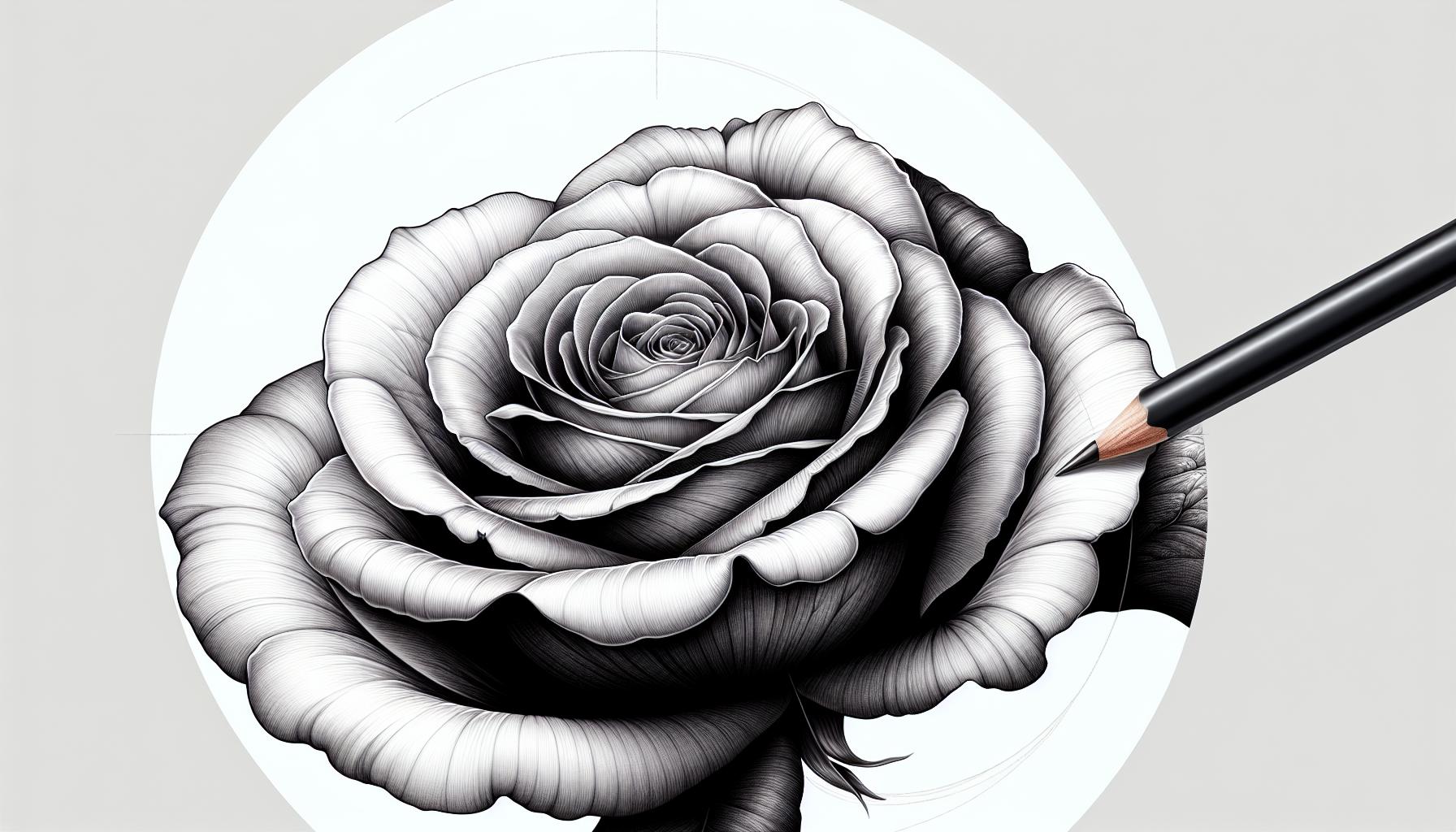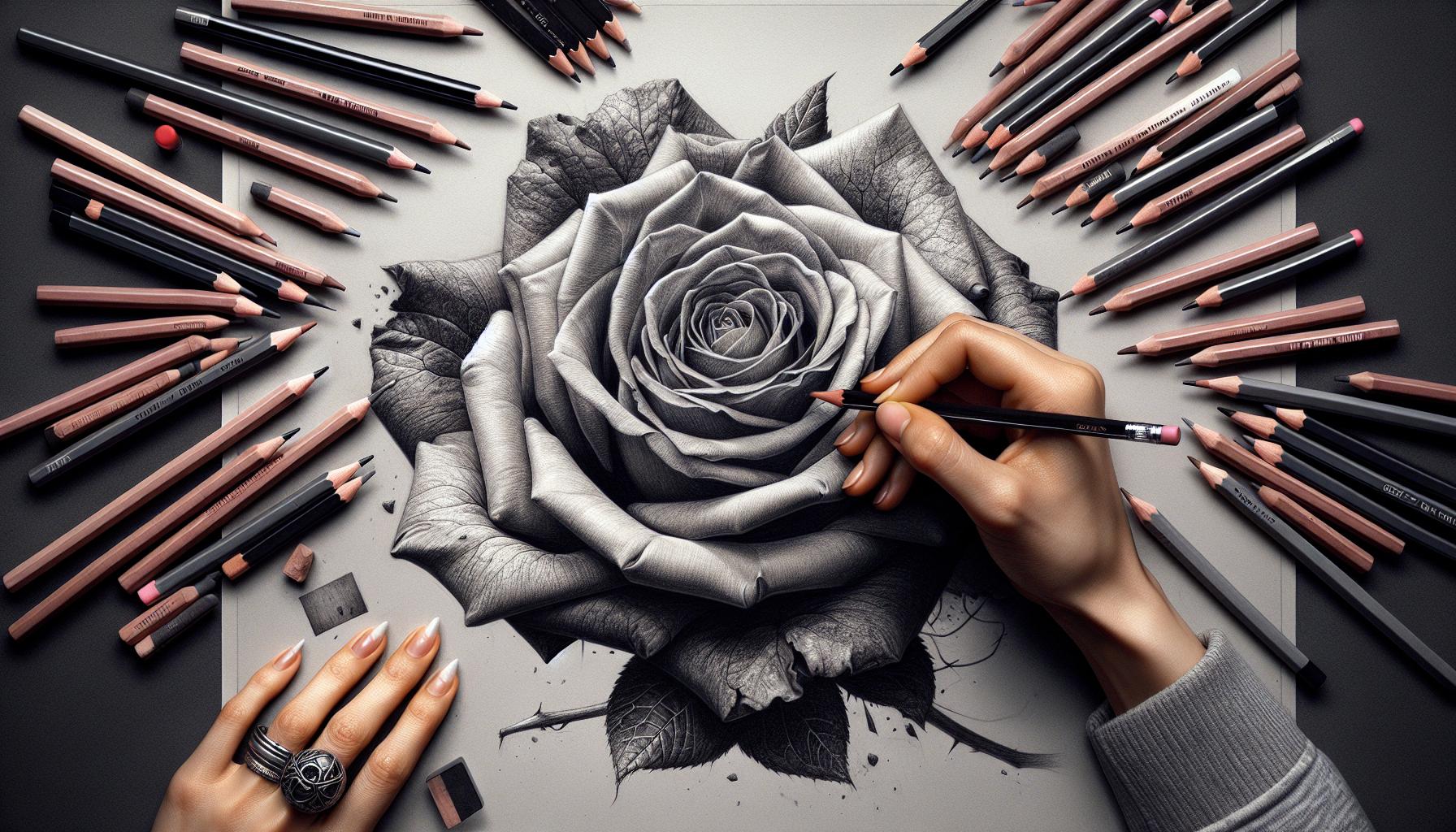Drawing a beautiful rose doesn’t have to be a thorny challenge. With the right guidance and simple techniques anyone can create stunning rose sketches that capture the flower’s delicate essence and natural beauty. Whether you’re a budding artist or just looking to explore your creative side drawing roses can be both relaxing and rewarding.
From basic line drawings to more detailed illustrations the art of sketching roses has captivated artists for centuries. Modern approaches have made it easier than ever to break down this classic subject into manageable steps. By focusing on basic shapes and gradually adding details even beginners can achieve impressive results that’ll make their artwork bloom.
Facil:llmyqtpygza= Rosa Dibujo
The rose drawing technique starts with mastering fundamental geometric shapes that form the foundation of a realistic flower sketch. These core principles establish the groundwork for creating visually appealing rose illustrations.
Basic Rose Shapes and Forms
Rose drawings begin with simple circular shapes for the center bloom. The primary form consists of an oval spiral pattern that expands outward, creating the characteristic layered petals. Each petal follows a curved C-shape pattern, overlapping the previous one to build depth. The outer petals emerge larger than inner ones, establishing a natural gradient in size. Starting with loose, fluid circles helps create an organic base structure for the rose head. Adding geometric guidelines divides the flower into sections, making it easier to maintain proper proportions.
- Blending stumps for smooth petal transitions
- Fine-point erasers for detailed corrections
- Drawing compass for initial circular guides
- Ruler for establishing scale guidelines
- Mechanical pencils (0.5mm) for intricate details
Step-by-Step Rose Drawing Guide

Creating a realistic rose drawing involves breaking down the flower into manageable components while focusing on proper proportions and petal placement. This systematic approach transforms complex floral elements into achievable steps.
Starting With Simple Petals
The initial rose petals emerge from a central point using basic C-shaped curves. Starting with 3-4 small petals in the center creates the foundation for the rose’s core structure. Each central petal measures approximately 1-2 centimeters in size, curving gently inward to form a tight cluster. Light pencil strokes (2H grade) establish the preliminary shapes, allowing for easy adjustments. The inner petals overlap slightly, creating natural shadows where they meet. A circular guideline with a 5-centimeter radius helps maintain proper petal placement around the center point.
Adding Layers and Dimension
Subsequent petal layers expand outward in a spiral pattern, increasing in size by 25% with each new layer. Each outer layer contains 5-7 petals, arranged in an alternating pattern to avoid alignment with inner petals. Shading techniques incorporate 3 distinct tones: light for petal highlights, medium for base color, and dark for overlapping areas. The outer petals curve outward at 45-degree angles, creating depth through strategic placement. Varied pressure points on the pencil produce texture differences between petal edges and centers. Cross-contour lines following petal curves enhance the three-dimensional appearance.
Creating Realistic Rose Details

Realistic rose details emerge through precise application of shading techniques combined with careful attention to texture variations. The interplay of light and shadow creates the distinctive characteristics that make each rose petal appear natural and three-dimensional.
Shading Techniques
Light source positioning determines the shading pattern across rose petals. Artists apply three distinct values: highlights on petal edges catching direct light, midtones in partially illuminated areas, and deep shadows in overlapping sections. Cross-hatching creates smooth gradients between these values, while stippling adds subtle texture variations. Graphite pencils ranging from 2H to 6B produce different tonal values, with softer leads creating darker shadows in petal folds. A kneaded eraser lifts graphite to create highlights that reflect natural light patterns found in rose petals.
Texture and Depth
Surface variations distinguish realistic roses from flat drawings through strategic mark-making techniques. Fine parallel lines following petal curves create natural ridges while small circular motions render velvety textures characteristic of rose petals. Varying pencil pressure produces subtle dimples across petal surfaces. Overlapping petals cast shadows that deepen toward the flower’s center, establishing spatial relationships. Artists incorporate delicate vein patterns using light strokes with hard pencils. Blending stumps smooth transitions between textured areas while maintaining distinct surface characteristics that capture a rose’s organic qualities.
Adding Color to Your Rose Drawing

Color brings roses to life, transforming simple sketches into vibrant botanical artwork. The application of color requires specific techniques that enhance the natural beauty of the rose while maintaining its realistic appearance.
Colored Pencil Methods
Layered colored pencil applications create rich tonal variations in rose petals. Artists start with light pink or red base colors, applying gentle circular strokes that follow the petal contours. Deeper reds concentrate in the shadow areas between petals, while lighter pinks highlight the areas where light strikes the flower. Burnishing techniques with white pencils blend colors seamlessly, producing a smooth surface texture. Color gradients emerge through 3-4 layers of progressively darker shades, building from the petal edges inward. Complementary greens enhance stem details while warm yellows add subtle undertones to petal centers.
Watercolor Techniques
Watercolor painting captures the delicate transparency of rose petals through wet-on-wet applications. Artists begin with a pale pink wash across all petals, allowing colors to blend naturally at the edges. Subsequent layers add depth through darker pigments applied to shadowed areas while the paper remains damp. A combination of crimson red drops multiple values into still-wet areas creates organic color variations. Negative painting techniques define petal edges with precise brush control. Dry brush details add texture to stems leaves after the initial layers dry. Small touches of pure pigment in shadow areas increase contrast depth.
Common Mistakes to Avoid
Artists encounter several critical errors when drawing roses that affect the final appearance of their sketches.
Making petals uniform in size creates an artificial appearance, as natural roses display varying petal dimensions. Drawing petals in perfect symmetry diminishes the organic quality of the rose, whereas natural flowers exhibit subtle irregularities.
Incorrect petal layering disrupts the realistic flow of the rose:
- Overlapping petals in random directions
- Creating sharp angles instead of smooth curves
- Positioning petals without following the spiral pattern
- Adding too many petals in confined spaces
Shading mistakes that flatten the drawing include:
- Using single-tone shadows across all petals
- Applying equal pressure throughout the sketch
- Neglecting cast shadows between petals
- Missing highlight points on curved surfaces
Proportion errors distort the overall composition:
- Drawing the center bloom too large
- Creating outer petals smaller than inner ones
- Misaligning the flower’s vertical axis
- Spacing petals inconsistently
Color application issues that diminish realism:
- Using flat single colors without layering
- Applying dark values before establishing light tones
- Mixing incompatible color combinations
- Failing to blend color transitions
Edge treatment problems affect petal definition:
- Creating hard outlines around each petal
- Drawing petals with identical edge qualities
- Missing the subtle curves at petal tips
- Overlooking natural petal folds
These technical oversights prevent artists from achieving botanical accuracy in their rose drawings. Recognizing these issues enables artists to develop more nuanced approaches to flower illustration.
Tips for Drawing Practice
Daily sketching sessions lasting 15-30 minutes enhance rose drawing skills through consistent practice. Artists benefit from maintaining a dedicated sketchbook exclusively for flower studies.
Essential Practice Techniques:
- Draw roses from multiple angles (front view side view 45-degree angle)
- Sketch individual petals separately to understand their shapes
- Practice basic geometric forms (circles ovals spirals) repeatedly
- Create quick 5-minute gesture drawings to capture overall form
- Study light patterns on real roses or reference photos
Drawing Exercise Sequence:
- Start with 10 loose circular shapes
- Progress to 15 overlapping C-curves
- Create 5 simplified rose outlines
- Complete 3 detailed petal studies
- Finish with 1 fully rendered rose drawing
Focus Areas for Improvement:
- Petal edge variations (smooth ruffled torn)
- Shadow placement in folded areas
- Texture development through mark-making
- Proportion relationships between petals
- Center spiral structure accuracy
- Fresh roses for direct observation
- High-resolution botanical photographs
- Online tutorial videos
- Botanical illustration books
- Digital reference libraries
Creating timed drawing exercises strengthens visual memory skills while building confidence in rose illustration techniques. Rotating between different drawing materials (graphite colored pencils ink) expands technical versatility. Recording progress through dated sketches tracks artistic development over time.
Drawing roses represents a beautiful blend of technical skill and artistic expression that’s accessible to everyone. Through dedicated practice and attention to fundamental techniques artists can create stunning botanical illustrations that capture the rose’s timeless elegance.
Success lies in mastering the basic geometric shapes building layers of petals and understanding how light interacts with the flower’s form. Whether working in graphite colored pencils or watercolors the key is patient observation and consistent practice.
With these guidelines even beginners can develop their skills and create realistic rose drawings that showcase nature’s intricate beauty. The journey of learning to draw roses offers not just artistic growth but also a deeper appreciation for one of nature’s most beloved flowers.

